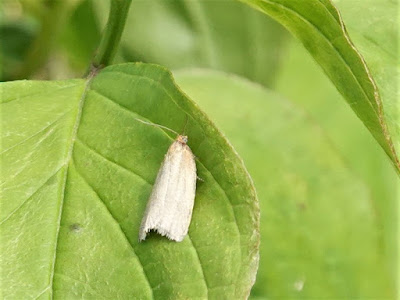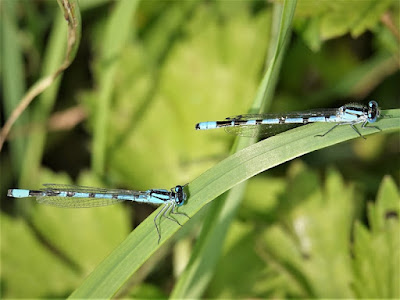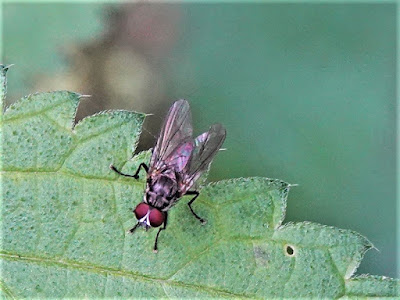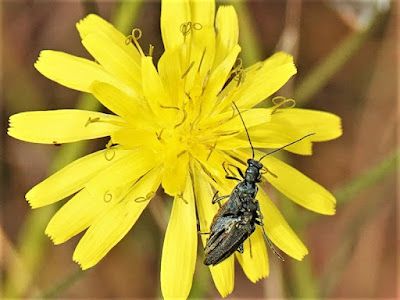15.0°C > 21.0°C: A misty murky start with low cloud and moderate visibility. Began to break with sunny intervals after 08:00, Staying hazy. Light south-easterly breeze. Moderate visibility, good at best.
Sunrise: 04:48 BST
* = a species photographed today
! = a new species for me here this year
!! = a new species for me in Shropshire
Priorslee Balancing Lake: 05:00 – 06:10 // 07:20 – 09:55
* = a species photographed today
! = a new species for me here this year
!! = a new species for me in Shropshire
Priorslee Balancing Lake: 05:00 – 06:10 // 07:20 – 09:55
(138th visit of the year)
Bird notes:
Counts of birds noted flying over:
- 19 Wood Pigeons
- 1 Herring Gull
- 10 Lesser Black-backed Gulls
- 1 Sparrowhawk
- 13 Jackdaws
- 2 Rooks
Hirundines etc. noted:
- 2 Swifts
- no Barn Swallows
- House Martins heard only: included a begging juvenile
Warblers noted (the figure in brackets relates to birds heard singing):
- 1 (1) Cetti's Warbler
- 13 (12) Chiffchaffs
- 8 (7) Reed Warblers
- 12 (12) Blackcaps
- 1 (1) Garden Warbler
- 1 (1) Common Whitethroat
'nominal' warbler:
- 3 (3) Goldcrests
Counts from the lake area:
- 2 Mute Swans
- 4 (3♂) Mallard
- 3 + 4 (1 brood) Moorhens
- 21 + 8 (5 broods) Coots
- 4 Great Crested Grebes
- 3 Lesser Black-backed Gulls
- 1 Grey Heron
Noted on the street lamps poles pre-dawn:
Moths:
- none
- none
Spiders:
- 1 Stout Sac Spider Clubiona sp.
- 1 Long-jawed Orb-web Spider Tetragnatha sp.
Noted later:
I concentrated on the area with the long grass without much success in finding anything new for the year. Mainly many hundreds of damselflies!
- 1 Stout Sac Spider Clubiona sp.
- 1 Long-jawed Orb-web Spider Tetragnatha sp.
Noted later:
I concentrated on the area with the long grass without much success in finding anything new for the year. Mainly many hundreds of damselflies!
Butterflies:
- Ringlet Aphantopus hyperantus : many
- Meadow Brown Maniola jurtina
- Ringlet Aphantopus hyperantus : many
- Meadow Brown Maniola jurtina
Moths:
- *!Horse-chestnut Leaf-miner Cameraria ohridella: leaf mines only
- *Common Marble Celypha lacunana
- Garden Grass-moth Chrysoteuchia culmella [was Garden Grass-veneer]
- *!White-banded Grass-moth Crambus pascuella [was Inlaid Grass-veneer]
- *Timothy Tortrix Zelotherses paleana
- *!Shaded Broad-bar Scotopteryx chenopodiata
- *!Horse-chestnut Leaf-miner Cameraria ohridella: leaf mines only
- *Common Marble Celypha lacunana
- Garden Grass-moth Chrysoteuchia culmella [was Garden Grass-veneer]
- *!White-banded Grass-moth Crambus pascuella [was Inlaid Grass-veneer]
- *Timothy Tortrix Zelotherses paleana
- *!Shaded Broad-bar Scotopteryx chenopodiata
Bees, wasps etc.:
- *Honey Bee Apis mellifera
- *sawfly of the Tenthredo arcuata / brevicornis / notha / schaefferi complex
- *Honey Bee Apis mellifera
- *sawfly of the Tenthredo arcuata / brevicornis / notha / schaefferi complex
Hoverflies:
The first name is that used by Stephen Falk. The name in square brackets is that given by Obsidentify or other sources if different. Scientific names are normally common. The species are presented in alphabetic order of those scientific names.
- Tapered Dronefly Eristalis pertinax
- Common Dronefly Eristalis tenax
- *Syrphus sp. S. ribesii / S. vitripennis
- Bumblebee Plume-horned Hoverfly Volucella bombylans
- Pellucid Fly Volucella pellucens [Pied Plumehorn]
- Tapered Dronefly Eristalis pertinax
- Common Dronefly Eristalis tenax
- *Syrphus sp. S. ribesii / S. vitripennis
- Bumblebee Plume-horned Hoverfly Volucella bombylans
- Pellucid Fly Volucella pellucens [Pied Plumehorn]
Damsel-/dragon-flies:
- *Common Blue Damselfly Enallagma cyathigerum
- Blue-tailed Damselfly Ischnura elegans
- *Common Blue Damselfly Enallagma cyathigerum
- Blue-tailed Damselfly Ischnura elegans
Other flies:
- Black Snipefly Chrysopilus cristatus : a new hatch?
- *dance fly probably Hybos culiciformis
- Greenbottle Lucilia sp.
- semaphore fly Poecilobothrus nobilitatus
- *a few unidentified flies
- Black Snipefly Chrysopilus cristatus : a new hatch?
- *dance fly probably Hybos culiciformis
- Greenbottle Lucilia sp.
- semaphore fly Poecilobothrus nobilitatus
- *a few unidentified flies
Bugs etc.:
- none
- none
Beetles:
- Alder Leaf Beetle Agelastica alni : just one!
- *False Blister Beetle Oedemera lurida or O. virescens
- Alder Leaf Beetle Agelastica alni : just one!
- *False Blister Beetle Oedemera lurida or O. virescens
Molluscs:
- White-lipped Snail Cepaea hortensis
- White-lipped Snail Cepaea hortensis
Spiders:
- *Furrow Orbweaver Larinioides cornutus
- *wolf spider, likely Common Wolf Spider Pardosa pullata
- *Furrow Orbweaver Larinioides cornutus
- *wolf spider, likely Common Wolf Spider Pardosa pullata
New flowers noted
- *Great Hairy Willowherb Epilobium hirsutum [also Greater Willowherb]
- *Small-flowered Crane’s-bill Geranium pusillum
- *Great Hairy Willowherb Epilobium hirsutum [also Greater Willowherb]
- *Small-flowered Crane’s-bill Geranium pusillum
The marks on the leaves are caused by the larva of the Horse-chestnut Leaf-miner Cameraria ohridella.
My best yet photos of a Common Marble moth Celypha lacunana?
Taken through a multitude of grass stems is my first White-banded Grass-moth Crambus pascuella of the year. I have inverted the photo for somewhat easier viewing. In previous years this species was called Inlaid Grass-veneer.
The pale yellow wash on the 'shoulder' of this moth identify it as a Timothy Tortrix Zelotherses paleana.
Another 'through the grass stems special' is my first Shaded Broad-bar moth Scotopteryx chenopodiata of the year. A variable species. This one has much more prominent shading and the 'broad bar' is the same tone as the rest of the wing. Some individuals have mauve shading.
Some Honey Bees Apis mellifera are more colourful than others. This bright one gave the impression of a hoverfly at first glance. The long antennae identify it as a bee.
One of the sawflies of the Tenthredo arcuata / brevicornis / notha / schaefferi complex
A Syrphus hoverfly, either S. ribesii or S. vitripennis.
Of all the hundreds and quite likely thousands of damselflies I have seen this year I have seen almost none paired. Here a male Common Blue Damselfly Enallagma cyathigerum has a female in his claspers.
...and this pair of Common Blue Damselflies are in full 'mating wheel' formation, the female with the tip of her abdomen attached to the male's sex organ. In some species after mating the male continues to grasp the female as she lays the eggs that he has fathered. This female shows no 'blue' colouration but is clearly mature.
Male Common Blue Damselflies do not always fight!
A dance fly probably Hybos culiciformis. When I saw the fly I thought it was showing a 'beak' suggesting it was one of the Empis dagger flies. From the photo I see that the 'beak' is the juxtaposition of the front right leg. Not the hairy and swollen hind femur.
Unknown fly sp. #1
Unknown fly sp #2. This long-legged fly was no larger that a typical blackfly.
Seems we will have more False Blister Beetles Oedemera lurida or O. virescens next year.
This is a Furrow Orbweaver spider Larinioides cornutus. It is very upset because I had just walked through its web, scattering all the trapped midges that it was looking forward to eating.
This is a wolf spider, likely Common Wolf Spider Pardosa pullata. As with others I have seen recently she (I assume) is carrying her eggs or spiderlings in a sac.
An abundant plant just coming in to flower. It is Great Hairy Willowherb Epilobium hirsutum. It is also known as Greater Willowherb.
I am still sometimes struggling to take flower photos with this camera. A not very good photo of Small-flowered Crane’s-bill Geranium pusillum.
Tail piece #2. I found this moth at rest later in the day. It looks very similar to many of the pug moths but is slightly larger. It is a Small Dusty Wave Idaea seriata
(Ed Wilson)
------------------------------------------------------------------------------------------------------
In the Priorslee Avenue tunnel:
Flies:
- *1 Tiger Cranefly Nephrotoma flavescens.
*** I have now identified yesterday's probable Nephrotoma sp. as N quadrifaria.
- *1 Tiger Cranefly Nephrotoma flavescens.
*** I have now identified yesterday's probable Nephrotoma sp. as N quadrifaria.
(Ed Wilson)
------------------------------------------------------------------------------------------------------
(141st visit of the year)
Bird notes:
Bird(s) noted flying over here:
- 1 Lesser Black-backed Gull
- 1 Jackdaw
Hirundines etc. noted:
- 1 House Martin
Warblers noted (the figure in brackets relates to birds heard singing):
- 5 (5) Chiffchaffs
- 4 (4) Blackcaps
'nominal' warbler:
- no Goldcrests
Noted on / around the water:
- 195 Canada Geese: goslings not identified
- 60 Greylag Geese
- no Canada x Greylag Goose
- 3 + 2 (1 brood) Mute Swan
- *24 + 2 (1 brood) Mallard: sexes not determined
- *8 (6♂) Tufted Duck
- 6 + 2 (1 brood) Moorhens
- 15 + 1 (1 brood) Coots
- 2 Great Crested Grebes
Noted elsewhere around The Flash:
Moths:
- 1 Tawny Grey Eudonia lacustrata : same place as yesterday
- 1 Tawny Grey Eudonia lacustrata : same place as yesterday
Flowers:
- *Tall Tutsan Hypericum x inodorum (H. androsaemum x H. hircinum)
- *Tall Tutsan Hypericum x inodorum (H. androsaemum x H. hircinum)
This pair of Mallard seem to have done reasonably well in protecting two of their brood. The ducklings are looking quite sturdy.
Many of the Tufted Ducks are getting hard to sex as they moult. Not these two: the grinning drake is on the left and the much browner duck on the right.
Assuming that Obsidentify is a better botanist that I am (not hard!) this is Tall Tutsan Hypericum x inodorum (H. androsaemum x H. hircinum). I suspect in previous years I have thought this to be one of the St. John's-worts, also Hypericum sps.
(Ed Wilson)
------------------------------------------------------------------------------------------------------
Sightings from previous years
2013
Priorslee Lake
Grasshopper Warbler
(Ed Wilson)
2012
Priorslee Lake
Special this morning was rather bizarre: an all-white, apparently albino, Budgerigar(!) sheltering in the copse between the football field and the playground!
(Ed Wilson)
2008
Priorslee Lake
Common Sandpiper
Another slight puzzle this morning. It sounded like a 'Blackcap with a difference' with an extended song with lots more variety than usual and many notes recalling Garden Warbler, Song Thrush and Blackbird. It was clearly NOT the bird from earlier but I was curious. It was always singing well above head-height (Acros tend to be below head-height) and never had the rhythm of an Acro but the long and flowing song was very strange (and very loud). In the end the bird gave itself up and proved to be what I thought - a 'Blackcap with a difference' - lots of testosterone? It proved my 'rule of thumb' - if you are not sure whether it is a Blackcap or a Garden Warbler it is a Blackcap.
(Ed Wilson)
























